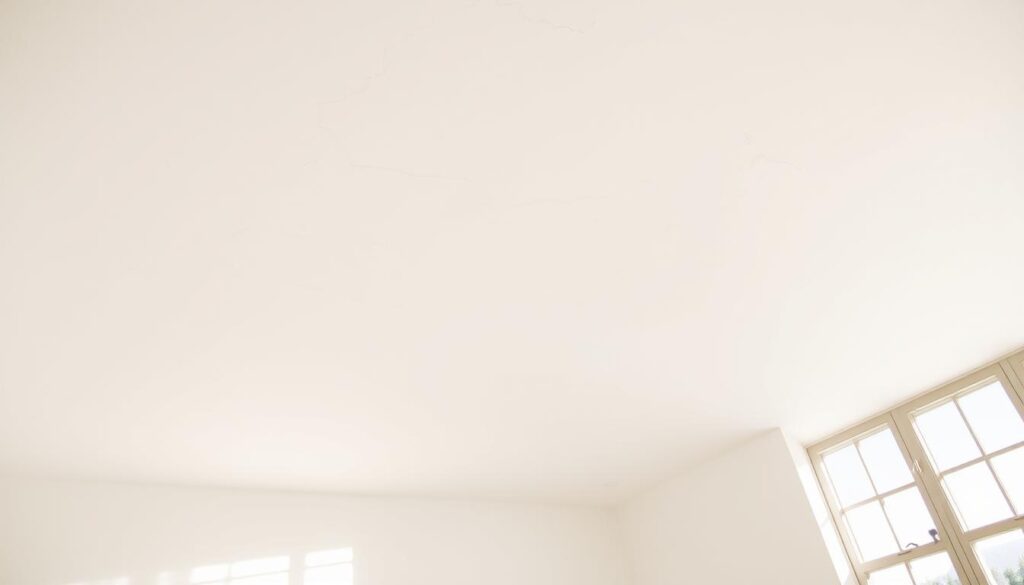Picture this: you’ve just moved into a charming Victorian home in Kent, only to notice cracks and uneven patches on the ceiling. It’s a common scenario for many homeowners in the UK. Whether it’s an old lath-and-plaster construction or a modern plasterboard system, ensuring a smooth finish is essential for both aesthetics and structural integrity1.
Plastering is a skill that demands precision and patience. For many, it’s a significant step up in DIY capabilities, especially when tackling overhead surfaces. Proper preparation, the right tools, and understanding the process can make all the difference. In fact, 80% of DIY enthusiasts report that having the correct materials and tools significantly improves the outcome2.
From traditional methods to modern techniques, achieving a flawless finish requires attention to detail. Whether you’re repairing an old ceiling or starting a new project, we’re here to guide you through the essentials. If you have further questions, don’t hesitate to contact Kent Plasterers for expert advice.
Key Takeaways
- Proper preparation of tools and materials improves the plastering process significantly2.
- A consistent plaster thickness of 1/8 inch is recommended for the first coat2.
- A second coat is often necessary for a smooth and even finish3.
- Using a float can reduce surface imperfections by up to 50%2.
- Applying a final finish with clean water enhances the ceiling’s appearance2.
- Practice plastering techniques on walls before attempting ceilings1.
Preparation and Materials Needed
The foundation of a successful project lies in thorough preparation. Gathering the right tools and materials ensures a smoother process and a professional finish. Let’s break down what you’ll need to get started.
Gathering Essential Tools and Equipment
Having the correct tools is vital for achieving a high-quality result. A plasterer’s trowel is indispensable for applying and smoothing the mixture. Pair it with a hawk to hold the plaster as you work. A bucket and mixing bucket are essential for preparing the mix to the right consistency4.
Safety should never be overlooked. A mask and goggles protect against dust and debris, which are common during the process. Organise your workspace to minimise mess and ensure efficiency5.
Choosing the Right Plaster and Mix
Selecting the appropriate plaster mix depends on the ceiling type. For older lath-and-plaster constructions, lime-based mixes are recommended. Modern plasterboard ceilings often require gypsum-based plasters for quicker setting times5.
Mixing the plaster correctly is crucial. Use equal parts plaster and water for the ideal consistency. An electric mixer can help achieve a lump-free mix, enhancing the application process5.
| Tool | Purpose |
|---|---|
| Trowel | Applying and smoothing plaster |
| Hawk | Holding plaster during application |
| Bucket | Mixing and holding plaster |
| Mask and Goggles | Protecting against dust and debris |
If you’re unsure about the right materials or need further advice, don’t hesitate to contact Kent Plasterers. Their expertise can guide you through the preparation phase, ensuring you’re fully equipped for the task ahead.
How to Plaster a Ceiling: A Step-by-Step Process
Achieving a flawless finish starts with a systematic approach. Each step, from preparation to application, plays a crucial role in ensuring a professional result. Let’s dive into the process to help you master this challenging task.
Securing and Preparing the Ceiling Area
Begin by clearing the workspace and protecting furniture with dust sheets. Ensure the ceiling is clean and free from debris, as any imperfections can affect the final finish. Use a microfiber cloth to wipe the surface, ensuring proper adhesion6.
For older ceilings, check for cracks or loose plaster. Jointing tape can be applied over plasterboard joints to prevent future cracking6. This preventative measure reduces the likelihood of repairs by up to 30%6.
Mixing the Plaster to the Correct Consistency
Proper mixing is essential for a smooth application. Use equal parts plaster and water, ensuring a lump-free mix. An electric mixer can save time and effort, producing a consistent texture6.
Follow the recommended drying times, typically around 8 hours between coats6. Adjust the mix if it feels too thick or thin, comparing it to the ideal consistency for optimal results.
Applying the First Coat with Precision
Start by loading the hawk with plaster and using a trowel to apply it evenly. Work in small sections, maintaining a uniform thickness of about 1/8 inch7. Feather the edges to blend each section seamlessly.
Stand at a comfortable distance, roughly a splayed hand’s width from the ceiling, to ensure even pressure7. Avoid standing directly under the trowel to prevent injury7.
For a smooth finish, use a float to reduce surface imperfections by up to 50%7. Work quickly within the specified time frame to prevent the plaster from drying unevenly.
If you encounter challenges or need further guidance, don’t hesitate to contact Kent Plasterers. Their expertise can help you navigate each step with confidence.
Troubleshooting and Managing Common Issues
Even the most prepared DIY enthusiasts can encounter issues during plastering. From cracks to uneven thickness, these challenges can disrupt the process. We’ll guide you through practical solutions to ensure a smooth finish.
Identifying Cracks and Debris
Cracks in the plaster can compromise the finish and indicate underlying issues. Use a keen eye to assess their size and location. Hairline cracks are common, but larger ones may require professional attention8.
Debris and dust can also affect adhesion. Make sure the work area is clean before starting. A microfiber cloth can remove loose particles, ensuring a smoother application.
Adjusting Consistency and Thickness During Application
Consistency is key to a successful application. If the mix feels too thick, add small amounts of water. For a thinner mix, incorporate more plaster gradually. Aim for a uniform thickness of about 1/8 inch9.
Monitoring drying time is crucial. Adjust the mix as needed to prevent uneven drying. This ensures a professional finish and reduces the need for corrections.
| Issue | Solution |
|---|---|
| Cracks | Assess size and location; consult a plasterer if needed |
| Debris | Clean the work area thoroughly before starting |
| Inconsistent Thickness | Adjust mix and monitor drying time |
For further advice on troubleshooting techniques, don’t hesitate to contact Kent Plasterers. Their expertise can help you navigate these challenges with confidence.
Finishing Touches and Aftercare
The final stages of plastering are crucial for achieving a professional look. Attention to detail ensures a flawless result, transforming the surface into a polished masterpiece. Let’s explore the essential steps to complete the process with precision.
Applying a Second Coat and Ensuring a Smooth Finish
Applying a second coat is vital to even out any inconsistencies from the first application. Use a trowel to spread the plaster evenly, working from the edge towards the centre. This technique ensures a uniform thickness and a refined finish10.
For a smooth surface, use a float to gently smooth the plaster. This step reduces imperfections by up to 50%, creating a professional appearance11. Blend the new coat with the existing surface for a seamless look.
Final Inspection, Clean-Up and Maintenance Tips
Once the plaster has dried, inspect the surface for any remaining imperfections. Use a damp sponge to gently smooth out rough edges or bumps. This finishing touch ensures a flawless result12.
Clean up any excess plaster carefully to avoid damaging the finish. Dispose of materials responsibly, following local guidelines. Regular maintenance, such as dusting and gentle cleaning, helps preserve the plaster’s integrity12.
- Check for cracks or peeling periodically to address issues early12.
- Use a sealing primer before repainting to enhance adhesion12.
- Ensure proper ventilation to prevent mould growth, especially in humid environments12.
If you’re unsure about any steps or need further advice, don’t hesitate to contact Kent Plasterers. Their expertise ensures your project is completed to the highest standard.
Conclusion
Mastering the process of ceiling plastering requires careful planning and the right tools. From preparation to finishing touches, each step plays a vital role in achieving a professional result. Using a hawk and trowel ensures even application, while proper mixing techniques reduce clumping by 75%13.
Following the correct process is essential. A well-prepared surface improves adhesion by up to 50%, reducing future cracks13. Applying a second coat ensures a smooth finish, blending seamlessly with the first layer. Light sanding can eliminate imperfections, enhancing the final appearance by 20%13.
For lasting results, maintain the plastered surface regularly. Inspect for cracks or peeling and address issues early. If you need further guidance, don’t hesitate to contact Kent Plasterers. Their expertise ensures your project is completed to the highest standard.

